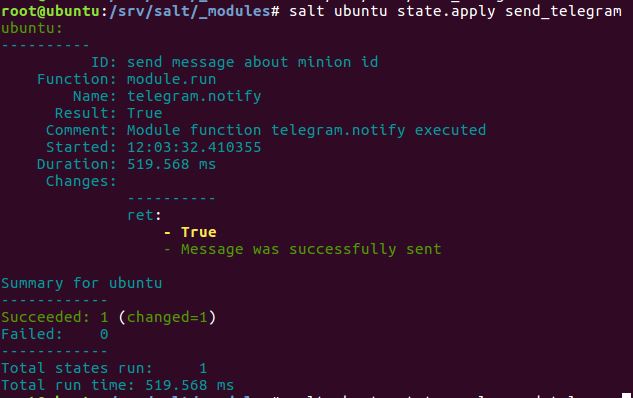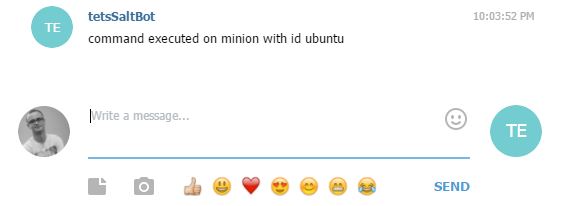Integration SaltStack and Telegram

In this article I would like to talk about sending notifications to the Telegram chat using SaltStack. Starting from version 2015.5.0, SaltStack provides integration with Slack out of the box, however Telegram is also a popular instant messenger and is actively used among Russian users. Therefore, I hope that the article will be useful to its readers.
Introduction
Generally speaking, SaltStack is a constructor and, like many other tools, provides opportunities for customization and expansion. In particular, its own executables .
How you can create Telegram bot in Python is described in detail here . As an addition, it will be described how, using a small Python module, this approach can be tied to SaltStack.
Setup process
To start writing a module should be after:
- Created bot
- Bot added to chat
- Chat_id received
Note. You can get the chat id using the following python script:
import requests URL = 'https://api.telegram.org/bot' TOKEN = < > try: request = requests.post('{url}{token}/getUpdates'.format(url=URL, token=TOKEN)) print request.json()['result'][0]['message']['chat']['id'] except Exception,e: print str(e) So, go to the main thing. As described in the documentation , the SaltStack module should be located in the _modules/ directory and look like this:
import requests URL='https://api.telegram.org/bot' def notify(message, token, chat_id): message_data = { 'chat_id': chat_id, 'text': message } try: request = requests.post('{url}{token}/sendMessage'.format(url=URL, token=token), data=message_data) except Exception,e: return False, str(e) if not request.status_code == 200: return False, "Return status is unsuccessful" # . return True, "Message was successfully sent" Next, you need to execute the command to synchronize the modules so that they appear on the minions:salt '*' saltutil.sync_modules
If everything is completed successfully, the result will be approximately as follows:

And finally, we create a state file (in this example, send_telegram.sls )
send message about minion id: module.run: # telegram - python-, notify - - name: telegram.notify - kwargs: message: command executed on minion with id {{ grains['id'] }} token: < > chat_id: <id Telegram> Check the functionality of the created module:salt '*' state.apply send_telegram
On the side of the master:

In chat:

Sources
')
Source: https://habr.com/ru/post/330028/
All Articles